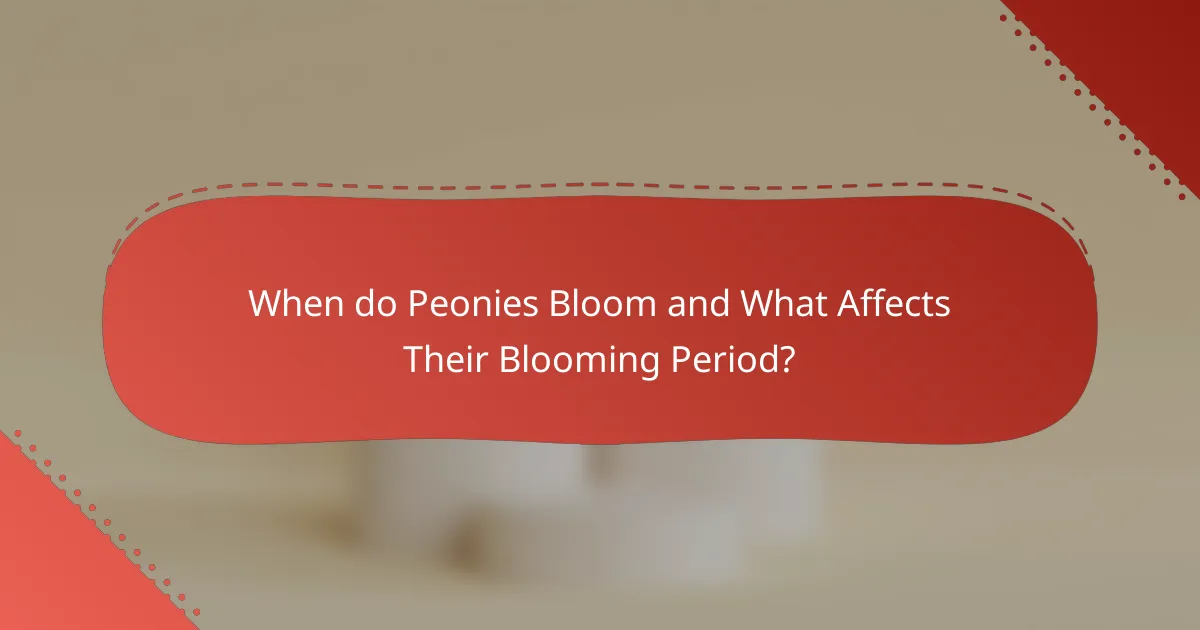
What are Peonies and Why are They Popular?
Peonies are flowering plants belonging to the genus Paeonia. They are known for their large, vibrant blooms and lush foliage. Peonies are popular for their aesthetic appeal and delightful fragrance. They thrive in temperate climates and are often used in gardens and floral arrangements. Their blooms come in various colors, including pink, white, and red. Peonies symbolize prosperity and good fortune in many cultures. They are also valued for their long-lasting cut flowers, which can last up to a week in arrangements. The popularity of peonies has increased due to their association with weddings and special occasions.
How do Peonies differ from other flowers?
Peonies differ from other flowers primarily due to their unique structure and blooming characteristics. They have large, lush blooms that can reach up to 10 inches in diameter. Peonies typically have a rounded shape and can be single, semi-double, or fully double in form. Their petals are often thick and waxy, providing a distinctive texture. Unlike many other flowers, peonies have a strong, sweet fragrance that is particularly noted in certain varieties. They bloom in late spring to early summer, with a shorter flowering period compared to some perennial flowers. Additionally, peonies are perennials that can live for decades, which is uncommon among many annual flowers. These attributes make peonies particularly sought after for gardens and floral arrangements.
What are the unique characteristics of Peonies?
Peonies are unique flowering plants known for their large, lush blooms. They typically feature rounded, full petals that can be single, semi-double, or double. Peonies come in various colors, including pink, white, red, and yellow. Their blooms can reach up to 10 inches in diameter. Peonies have a distinct, sweet fragrance that varies among species. They are perennials, often living for decades in gardens. Peonies thrive in well-drained soil and require full sun for optimal growth. They typically bloom in late spring to early summer, depending on the variety. These characteristics make peonies a popular choice for ornamental gardens.
Why are Peonies favored in gardens and floral arrangements?
Peonies are favored in gardens and floral arrangements for their large, fragrant blooms. These flowers come in various colors, enhancing visual appeal. They bloom in late spring to early summer, providing vibrant seasonal interest. Peonies are also known for their longevity as cut flowers, lasting up to a week in arrangements. Their lush foliage adds texture to gardens, making them visually striking even when not in bloom. Additionally, peonies symbolize romance and prosperity, adding emotional significance to floral displays. Their resilience and low maintenance requirements make them popular among gardeners. Overall, the combination of beauty, fragrance, and symbolism contributes to their favored status.
What are the different types of Peonies?
There are several types of peonies, primarily categorized into herbaceous, tree, and intersectional varieties. Herbaceous peonies are known for their lush foliage and vibrant blooms. They die back to the ground each winter and re-emerge in spring. Tree peonies have woody stems and can grow much larger than herbaceous types. They produce large, often fragrant flowers. Intersectional peonies, also known as Itoh peonies, are hybrids between herbaceous and tree peonies. They combine the best traits of both types, offering robust flowers and strong stems. Each type has unique characteristics that appeal to different gardeners and landscapes.
What are the main classifications of Peonies?
The main classifications of peonies are herbaceous, tree, and intersectional. Herbaceous peonies die back to the ground each winter and regrow in spring. Tree peonies have woody stems and can grow larger over time. Intersectional peonies are hybrids between herbaceous and tree peonies, combining traits from both types. These classifications help gardeners select the right peony for their landscape. Each type has distinct growth habits and care requirements.
How do the varieties of Peonies differ in appearance and fragrance?
Varieties of peonies differ in appearance and fragrance significantly. Some peonies have large, round blooms, while others feature more delicate, open petals. Colors range from soft pastels to vibrant reds and purples. Fragrance varies as well; some peonies emit a sweet, strong scent, while others are more subtle. For instance, the ‘Sarah Bernhardt’ variety is known for its large, fragrant pink blooms. In contrast, the ‘Festiva Maxima’ has white flowers with a hint of red and a strong fragrance. Overall, the diversity in peony varieties contributes to their unique visual and aromatic appeal.

What is the Fragrance of Peonies?
The fragrance of peonies is often described as sweet and floral. This scent can vary between different peony varieties. Some peonies emit a light, delicate aroma, while others have a stronger, more intense fragrance. The scent is typically most pronounced in the morning when the flowers are fully open. Studies indicate that peonies produce essential oils that contribute to their unique fragrance profile. These oils include various aromatic compounds, enhancing their appeal in gardens and floral arrangements. Peonies are popular in perfumery due to their captivating scent.
How does the fragrance of Peonies vary among different types?
The fragrance of peonies varies significantly among different types. Herbaceous peonies often have a sweet, light scent. Tree peonies typically emit a more intense and musky aroma. Intersectional peonies combine traits from both types, resulting in a unique fragrance profile. Some varieties, like ‘Sarah Bernhardt,’ are renowned for their strong, sweet scent. Others, such as ‘Festiva Maxima,’ offer a more subtle fragrance. Environmental factors can also influence scent intensity, including soil type and climate. Overall, the fragrance diversity among peony types adds to their appeal in gardens and floral arrangements.
What are the most fragrant Peony varieties?
The most fragrant Peony varieties include ‘Sarah Bernhardt’, ‘Festiva Maxima’, and ‘Duchess de Nemours’. ‘Sarah Bernhardt’ is renowned for its sweet, classic peony scent. ‘Festiva Maxima’ offers a strong fragrance with white petals and red flecks. ‘Duchess de Nemours’ is known for its soft, delicate aroma. These varieties are often highlighted in gardening literature for their exceptional fragrance. Their scents contribute to their popularity among gardeners and floral enthusiasts.
How does environmental conditions affect Peony fragrance?
Environmental conditions significantly affect peony fragrance. Factors such as temperature, humidity, and soil quality influence the intensity and quality of their scent. Higher temperatures can enhance the release of volatile compounds responsible for fragrance. Conversely, extreme heat may cause blooms to fade faster, reducing scent duration. Humidity also plays a role; optimal moisture levels can improve fragrance strength. Poor soil conditions can lead to weaker plants, which may produce less aromatic flowers. Studies show that peonies grown in ideal environments exhibit richer and more complex fragrances.
Why is the fragrance of Peonies significant?
The fragrance of peonies is significant due to its association with beauty and emotional well-being. The scent of peonies is often described as sweet and floral, evoking feelings of happiness and nostalgia. Research indicates that pleasant fragrances can enhance mood and reduce stress levels. In traditional cultures, peony fragrance symbolizes prosperity and good fortune. The unique aroma of peonies also attracts pollinators, playing a crucial role in their reproduction. Additionally, the fragrance is a key factor in their popularity in gardens and floral arrangements. Overall, the significance of peony fragrance lies in its emotional, cultural, and ecological impacts.
How does the fragrance influence the popularity of Peonies?
The fragrance of peonies significantly enhances their popularity. This floral scent is often described as sweet and intoxicating. Many people associate the fragrance with romance and beauty. The appealing aroma attracts gardeners and floral enthusiasts alike. Studies show that scent plays a crucial role in flower selection. A strong fragrance can increase a flower’s desirability. Peonies with a notable scent often command higher prices in the market. Their fragrance also contributes to their use in perfumes and home fragrances, further boosting their appeal.
What role does fragrance play in gardening and landscaping?
Fragrance plays a significant role in gardening and landscaping by enhancing the sensory experience of outdoor spaces. It attracts pollinators, such as bees and butterflies, which are essential for plant reproduction. Many plants, including peonies, are chosen for their pleasant scents, contributing to the overall aesthetic and ambiance of gardens. Fragrant plants can also mask unpleasant odors in the environment. Furthermore, specific fragrances can evoke emotions and memories, creating a more enjoyable atmosphere. Studies show that gardens with aromatic plants can improve mental well-being and relaxation. Thus, incorporating fragrance into landscaping designs enriches the overall gardening experience.

When do Peonies Bloom and What Affects Their Blooming Period?
Peonies typically bloom in late spring to early summer. The exact blooming period can vary based on the climate and specific variety of peony. Most peonies bloom between late April and early June. Factors affecting their blooming period include temperature, sunlight, and soil conditions. Warmer temperatures can lead to earlier blooms, while colder climates may delay them. Additionally, the type of peony, such as herbaceous, tree, or intersectional, influences the timing of blooms. Proper care, including adequate watering and fertilization, can also impact the blooming period.
What is the typical blooming period for Peonies?
The typical blooming period for peonies is late spring to early summer. Specifically, peonies usually bloom from late May to early June. This blooming period can vary slightly based on the climate and specific variety of peony. For instance, early-blooming varieties may start flowering in mid-May, while late-blooming types can extend into June. Peonies require a certain amount of chill hours to thrive, which influences their blooming time. The exact timing can also be affected by local weather conditions, such as temperature fluctuations.
How does climate impact the blooming period of Peonies?
Climate significantly impacts the blooming period of peonies. Temperature and weather conditions determine when peonies bloom. Warmer temperatures can lead to earlier blooming. Conversely, colder temperatures may delay blooming. Peonies typically require a certain number of chilling hours for optimal growth. Insufficient chill hours can result in poor flowering. Additionally, fluctuations in climate, such as unexpected frosts, can damage buds. This can further disrupt the blooming schedule of peonies. Studies have shown that climate change is altering bloom times for many plants, including peonies.
What are the signs that Peonies are about to bloom?
Peonies show several signs that they are about to bloom. One clear sign is the appearance of buds that swell and change color. These buds typically become larger and may show hints of the flower color. Another sign is the softening of the buds, indicating they are nearing opening. The leaves around the buds may also appear fuller and greener. Additionally, the overall plant will display vigorous growth as it prepares to bloom. This growth usually occurs in late spring, aligning with the peony’s blooming period. Observing these signs helps gardeners anticipate the bloom.
What factors influence the blooming success of Peonies?
The blooming success of Peonies is influenced by several key factors. These include sunlight exposure, soil quality, and proper watering. Peonies thrive in full sun, requiring at least six hours of direct sunlight daily. The soil should be well-drained and rich in organic matter to support healthy growth. Overwatering can lead to root rot, while insufficient moisture can hinder blooming. Additionally, the choice of Peony variety affects blooming timing and success. Certain varieties are more resilient to environmental changes. Proper spacing between plants also allows for adequate air circulation, reducing disease risk. These factors collectively determine the overall blooming success of Peonies.
How does soil quality affect Peony blooming?
Soil quality significantly affects peony blooming. Healthy soil provides essential nutrients and proper drainage. Peonies thrive in well-drained, loamy soil rich in organic matter. Poor soil quality can lead to stunted growth and reduced flowering. Soil pH also plays a crucial role; peonies prefer a pH between 6.0 and 7.0. High acidity or alkalinity can inhibit nutrient uptake. Additionally, compacted soil restricts root development, affecting overall plant health. Research indicates that optimal soil conditions can enhance blooming and flower size.
What role does sunlight play in the blooming process?
Sunlight is crucial for the blooming process of peonies. It provides the energy needed for photosynthesis, which fuels plant growth and flower development. Adequate sunlight exposure promotes healthy foliage, enabling the plant to produce the nutrients necessary for blooming. Peonies typically require at least six hours of direct sunlight daily for optimal flowering. Insufficient sunlight can lead to weak stems and fewer blooms. Studies show that peonies grown in full sun produce larger and more vibrant flowers compared to those in shaded areas. Thus, sunlight directly influences the quality and quantity of peony blooms.
What are the best care tips for Peonies?
Peonies thrive with proper care. They require full sun for at least six hours daily. Well-drained soil is essential for their growth. Water them deeply but infrequently to avoid root rot. Fertilize in early spring with a balanced fertilizer for optimal blooming. Support taller varieties with stakes to prevent breakage. Deadhead spent blooms to encourage more flowers. In fall, cut back foliage to ground level after it has died back. These practices ensure healthy peony plants and vibrant blooms.
How should Peonies be planted for optimal growth?
Peonies should be planted in well-drained soil and in a location that receives full sun. The ideal planting depth is 1 to 2 inches below the soil surface. This depth allows the eyes of the peony tubers to be positioned correctly for growth. It is crucial to space the plants about 3 to 4 feet apart to ensure adequate air circulation. Peonies thrive in soil with a pH between 6.0 and 7.0. Adding organic matter can improve soil quality and drainage. Water the plants thoroughly after planting to help establish their roots. Mulching can help retain moisture and suppress weeds. Following these guidelines ensures optimal growth and blooming.
What maintenance practices are essential for healthy Peonies?
Essential maintenance practices for healthy peonies include proper watering, mulching, and pruning. Peonies require consistent moisture, especially during their growing season. Watering should be deep but infrequent to encourage deep root growth. Mulching helps retain soil moisture and suppress weeds. Applying a layer of organic mulch around the base is beneficial. Pruning is crucial for promoting air circulation and preventing disease. Deadheading spent blooms also encourages more flowers. Fertilizing with a balanced, slow-release fertilizer in early spring supports growth. These practices, when consistently applied, lead to robust and vibrant peonies.
How can common Peony problems be addressed effectively?
Common Peony problems can be addressed effectively through proper care and management. Regularly inspect plants for pests such as aphids and spider mites. Use insecticidal soap or neem oil to treat infestations. Ensure adequate watering, as Peonies require consistent moisture but do not tolerate waterlogged soil. Apply mulch to retain soil moisture and prevent weed competition. Fertilize with a balanced fertilizer in early spring to promote healthy growth. Proper spacing between plants improves air circulation, reducing the risk of fungal diseases. Lastly, cut back foliage in the fall to prevent disease carryover. Following these practices can lead to healthier Peonies and improved blooming.
Peonies, belonging to the genus Paeonia, are renowned for their large, colorful blooms and sweet fragrance, making them a popular choice in gardens and floral arrangements. This article explores the unique characteristics of peonies, including their blooming period, which typically occurs in late spring to early summer, and the factors that influence their blooming success, such as sunlight and soil quality. Additionally, it provides essential care tips for maintaining healthy peonies, addressing common problems and maintenance practices to ensure vibrant growth. The article also highlights the significance of peony fragrance in enhancing emotional well-being and its impact on their popularity in gardening and landscaping.
